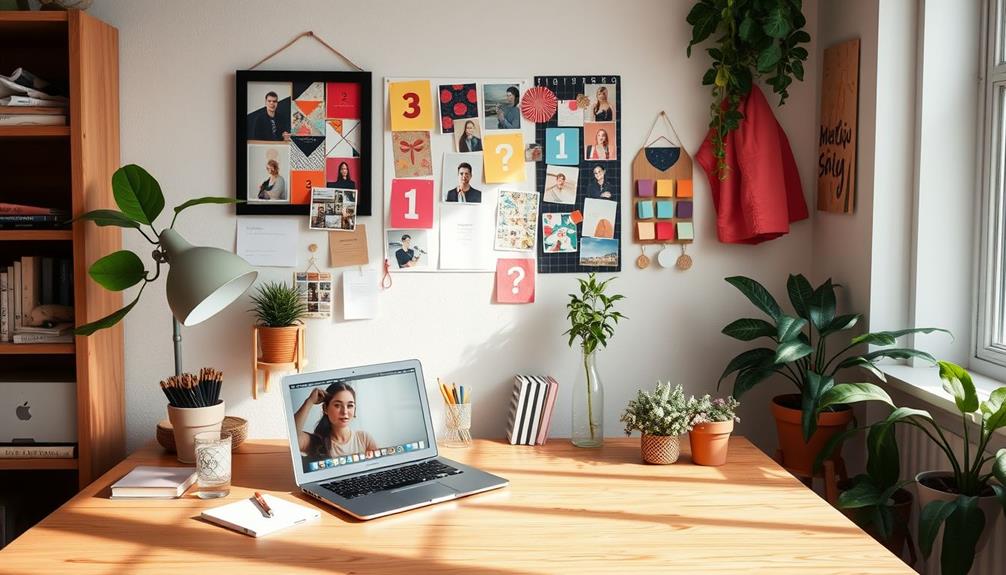To promote your interior design business on Instagram, enhance your profile with a professional picture and a compelling bio that highlights your unique value. Post consistently, ideally 2-3 times a week, and engage your audience with intriguing captions that tell a story. Use 3-5 relevant hashtags per post to boost discoverability and experiment with timing for peak visibility. Collaborate with local designers or influencers to widen your reach, and encourage clients to share their own designs with branded hashtags. This approach not only builds community but also enhances credibility—there's so much more to discover about elevating your presence!
Key Takeaways
- Optimize your profile with a professional logo, catchy bio, and easy contact access to enhance discoverability.
- Post consistently using a content calendar, targeting peak engagement times to maximize visibility and interaction.
- Utilize engaging captions that tell a story, ask questions, and incorporate relevant hashtags for improved reach.
- Leverage video content like project tours and tutorials to showcase design expertise and boost audience engagement.
- Foster community by encouraging user-generated content, hosting contests, and collaborating with influencers to expand your reach.
Consistent Posting Strategies
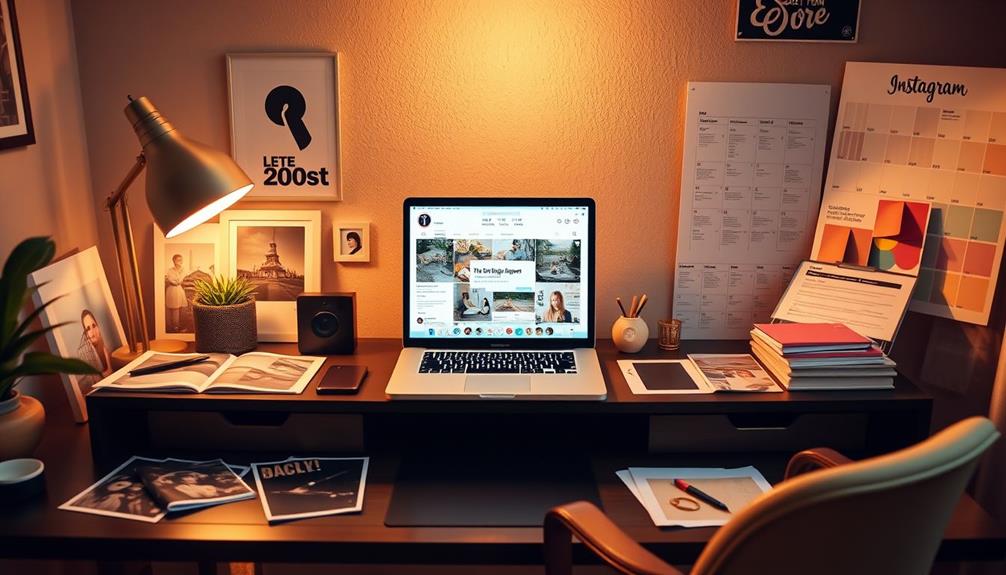
When aiming to grow your interior design presence on Instagram, posting consistently is essential. You should target a frequency of 2-3 times a week to 1-2 times daily, as this helps you build a loyal and engaged following without overwhelming your audience.
To make this easier, utilize a content calendar to plan and schedule your posts in advance. This guarantees you maintain a balanced mix of content while reducing last-minute stress.
Timing your posts is vital, too. Aim to share your content during early morning and evening hours, when engagement rates are typically higher.
Don't forget to craft engaging captions that prompt interaction; they can greatly enhance your posts' impact and help increase engagement.
As you implement these consistent posting strategies, regularly monitor engagement metrics to identify ideal posting times and content types. This will allow you to adjust your strategy based on audience behavior, helping you to build a personal connection with your followers.
Optimize Your Profile

To make a strong impression on potential clients, optimizing your Instagram profile is essential. A well-structured profile not only enhances your discoverability but also conveys your brand's unique value proposition.
Here are three key elements to focus on:
- Profile Picture: Use a high-quality profile picture, like your company logo. This helps create a professional visual identity and guarantees brand consistency across platforms.
- Bio Page: Craft a catchy bio that succinctly communicates what you do, incorporating relevant keywords. This will enhance your profile's discoverability and help potential clients understand your unique offerings at a glance.
- Contact Information: Make your contact information easily accessible. Use Instagram's business features to include your email, phone number, and website links.
Additionally, utilize a clickable link in your bio to direct followers to your website or a specific landing page, increasing engagement and conversion opportunities.
Craft Engaging Captions
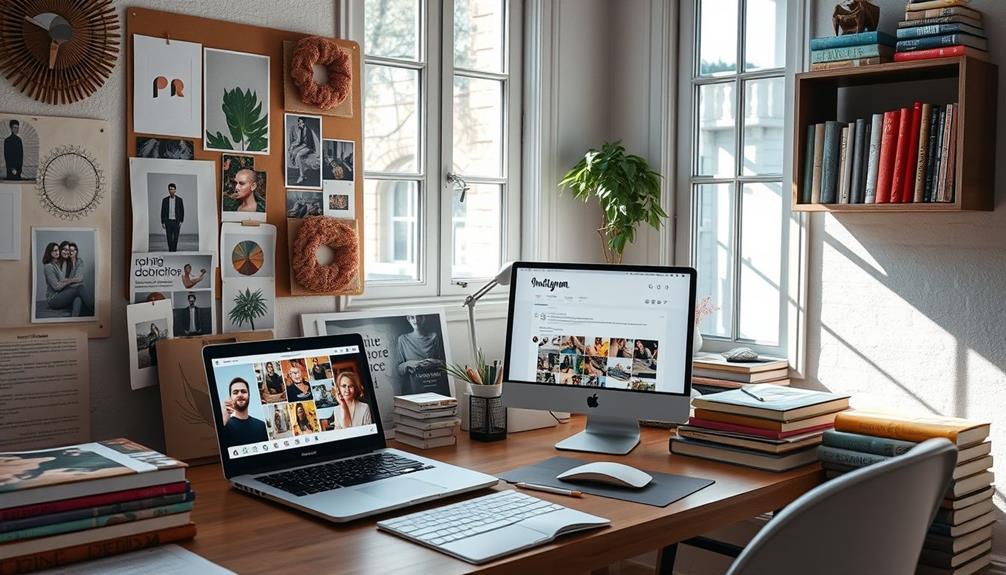
Crafting engaging captions is key to connecting with your audience and showcasing your interior design projects effectively. When you craft engaging captions, focus on telling a story about your design process or the inspiration behind your work. For instance, incorporating elements of cottagecore home office design can evoke a sense of tranquility and creativity, enhancing your narrative.
Context-rich captions can enhance engagement and foster a deeper connection with your audience. To encourage interaction, consider incorporating questions or prompts in your captions. Posts with at least one question can see a 50% increase in engagement, making them a powerful marketing tool in your Instagram marketing strategy.
Keep your captions concise yet informative, ideally between 138-150 characters, to maximize engagement. Don't forget to maintain a consistent brand voice and tone, which helps build trust and loyalty within your community.
By using relevant keywords and incorporating hashtags for each post, you'll improve your discoverability among potential clients seeking interior design inspiration. These strategies not only boost your visibility but also contribute to building a stronger design community on Instagram.
Utilize Hashtags Effectively
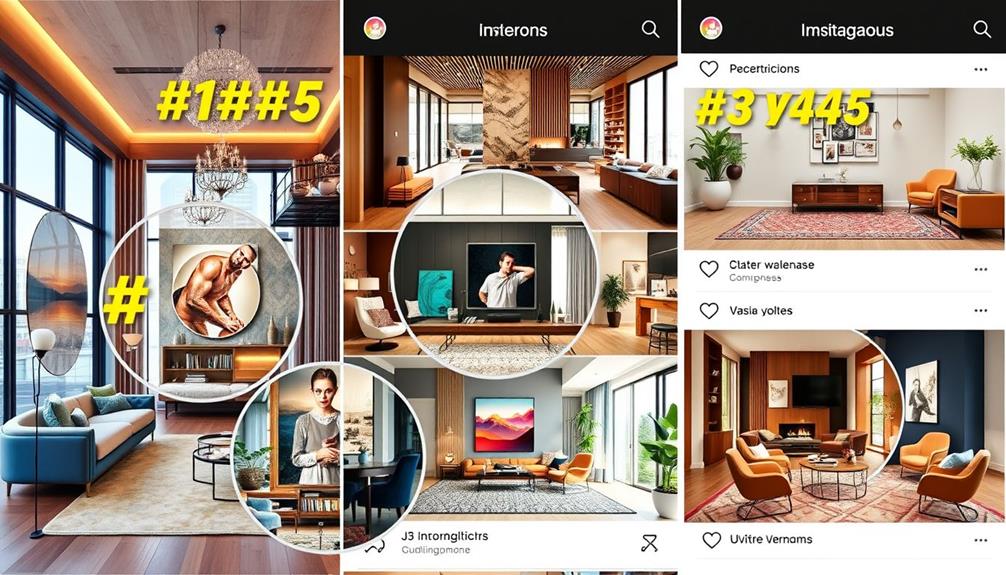
Engaging captions set the stage for your posts, but utilizing hashtags effectively takes your Instagram strategy to the next level. By mastering hashtags, you can greatly boost your visibility and engagement in the interior design niche.
Here are three key strategies to optimize your hashtag game:
- Limit Your Hashtags: Stick to 3-5 highly relevant hashtags per post. This approach minimizes spammy appearances while enhancing engagement. Research suggests that fewer hashtags often lead to better reach.
- Mix It Up: Use a combination of popular and niche-specific hashtags. Trending hashtags can attract broader audiences, while niche tags connect you with targeted communities.
- Create a Branded Hashtag: Develop a unique hashtag for your business to encourage user-generated content. This fosters community engagement and allows followers to share their experiences with your designs.
Lastly, regularly check Instagram Insights to analyze your hashtag performance. Identify which ones drive the most engagement and adjust your strategy based on current trends and competitor analysis.
Timing Your Posts

Timing your posts can make all the difference in how your interior design content is received on Instagram. To maximize visibility and engagement, aim to post during peak times, typically early morning (7-9 AM) and evening (5-9 PM). This strategy helps you connect with your audience when they're most active.
Use Instagram Insights to analyze your followers' activity patterns and refine your posting schedule accordingly.
Experimenting with different posting times over a few weeks allows you to gather valuable data on what resonates best with your specific audience. Keep an eye on engagement metrics after each post; this will help you adjust your timing strategy to better align with audience behavior.
Consistent posting at ideal times fosters a routine for your followers, which can greatly increase their loyalty and interaction with your content. When you establish this consistency, your audience knows when to expect new posts, making them more likely to engage with your work.
Collaborate With Others

Building strong connections in your industry can greatly boost your Instagram presence. When you collaborate with others, you not only enhance your creativity but also foster a sense of community by reimagining how you work together.
Here are three effective ways to collaborate:
- Engage in Joint Projects: Partner with local designers or artists. This approach allows you to showcase unique styles and ideas, appealing to diverse audiences interested in your services.
- Host Collaborative Events: Organize workshops or events with other professionals. These gatherings position you as a community leader and create valuable networking opportunities, which can lead to future client referrals.
- Utilize Influencer Partnerships: Collaborate with influencers to increase your brand visibility. Their trusted recommendations can boost consumer trust by 61% compared to traditional ads.
Leverage Video Content
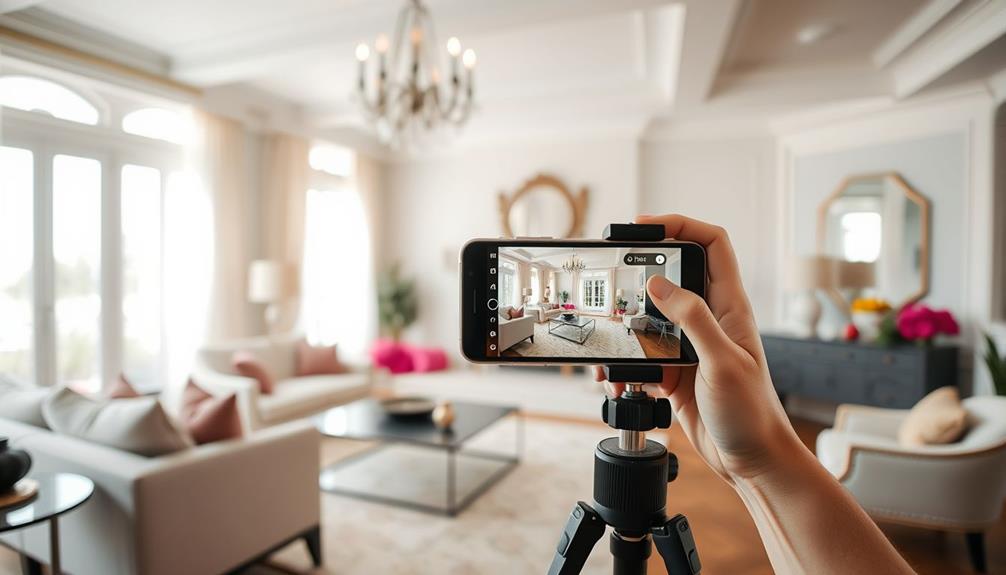
Video content is a powerful tool for showcasing your interior design expertise on Instagram. By leveraging various video formats, you can enhance engagement and connect with your audience more effectively. Here's a quick look at different types of video content you can create:
| Video Type | Purpose |
|---|---|
| Project Tours | Showcase detailed design transformations |
| Time-lapse Videos | Capture the design process visually |
| Educational Content | Share tips and DIY tutorials |
Utilizing Instagram Reels for short, engaging videos can increase your engagement by 48% compared to static posts. Time-lapse videos are particularly effective for illustrating transformations, making your designs more shareable. Don't forget to incorporate educational content, positioning yourself as an authority in design.
For more in-depth storytelling, leverage IGTV to conduct project tours or discuss design concepts. This platform allows for a richer narrative than standard posts. Finally, regularly review your video analytics to track engagement metrics. By understanding viewer preferences, you can refine your content strategy, ensuring your video content resonates with your audience and drives interest in your design projects.
Engage With Influencers

Partnering with influencers can greatly elevate your interior design brand on Instagram. By collaborating with the right individuals, you can enhance your brand credibility and reach new audiences who appreciate your interior design aesthetic.
Here are three effective ways to engage with influencers:
- Choose the Right Influencers: Focus on micro-influencers who align with your aesthetic and have a dedicated following. They often boast higher engagement rates and can offer targeted consumer recommendations.
- Encourage Authentic Content Creation: Invite influencers to share their genuine experiences with your designs. This approach fosters trust and engagement, making their endorsements feel more relatable to their audience.
- Build Long-Term Relationships: Instead of one-off promotions, aim for ongoing content collaborations. This strategy not only keeps your brand visible but also cultivates loyalty and authentic endorsements over time.
Encourage User-Generated Content
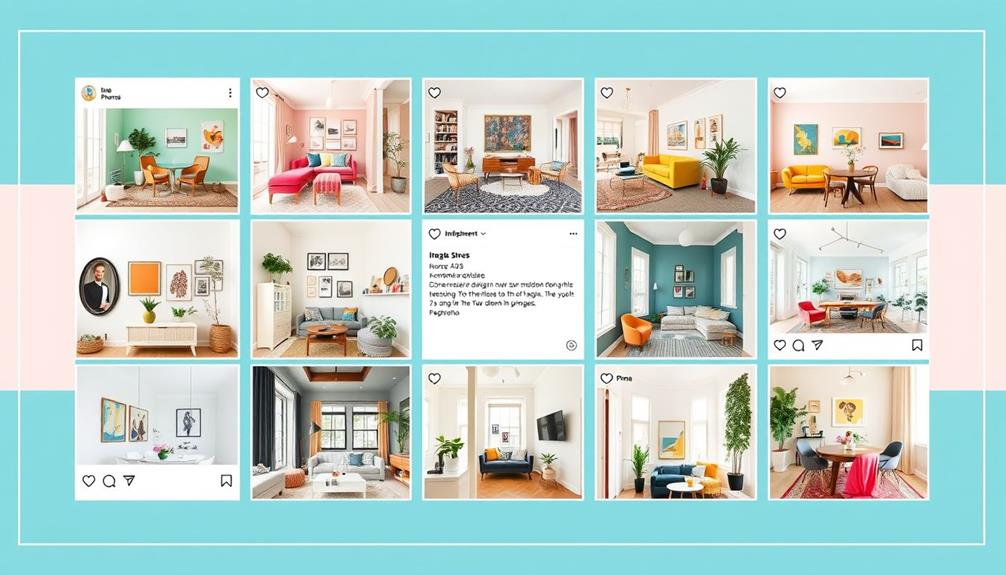
Encouraging user-generated content can greatly enhance your brand's presence on Instagram.
Offer incentives like discounts for clients who share their completed projects using your branded hashtag, and make sure to showcase their creations in your feed.
This not only builds community engagement but also strengthens the connection between your brand and your audience.
Incentives for Participation
When you create a vibrant community around your interior design brand on Instagram, incentives for participation can play an essential role in driving user-generated content (UGC).
By encouraging your followers to share their design projects, you not only enhance community engagement but also increase visibility for your brand.
Here are three effective strategies to take into account:
- Contests and Challenges: Launch a themed design challenge, using branded hashtags like #YourBrandDesignChallenge to track entries. Offer prizes or features on your profile to motivate participation.
- Exclusive Discounts: Provide exclusive discounts to followers who tag your business in their posts or use your branded hashtags. This not only incentivizes sharing but also drives sales.
- Highlight Testimonials: Share testimonials and success stories from satisfied clients. This encourages others to post about their experiences, enhancing engagement and fostering a sense of community.
Showcase User Creations
Showcasing user creations is a powerful way to build community and boost engagement on your Instagram profile. By encouraging clients to share photos of completed projects featuring your designs, you can create a branded hashtag that fosters user-generated content. This not only enhances community engagement but also amplifies your brand's visibility.
Consider offering incentives, like contests or giveaways, to motivate followers to post their own design photos. Highlight user-generated content by featuring satisfied clients and their beautiful spaces on your profile and stories. This authentic content builds trust and credibility with potential customers, showing them real-life applications of your work.
Don't forget to actively engage with these user-generated posts by liking, commenting, and sharing. This interaction fosters a sense of community and encourages more clients to participate in showcasing their creations.
Incorporating testimonials from users alongside their photos can greatly boost engagement and influence potential clients' purchasing decisions. By showcasing user creations, you're not just promoting your designs; you're building a vibrant community that celebrates your work and inspires others to join in.
Build Community Engagement
Building community engagement goes hand in hand with showcasing user creations. By encouraging user-generated content (UGC), you create a vibrant community around your interior design brand.
Here are three effective ways to foster that engagement:
- Utilize a Branded Hashtag: Encourage followers to share their design projects using a unique hashtag. This not only boosts UGC, but also strengthens community ties.
- Run Contests or Challenges: Invite users to submit their design photos with a chance to win prizes or be featured on your profile. This incentive can spark creativity and participation.
- Engage with Polls or Questions: Use Instagram Stories to ask your audience for feedback or suggestions. This makes them feel valued and involved in your design process.
Additionally, regularly showcase UGC on your feed to highlight your audience's creativity.
Sharing testimonials from satisfied clients builds credibility and encourages others to share their experiences.
Conclusion
Promoting your interior design business on Instagram might seem intimidating, but with the right strategies, you can truly shine. By consistently posting, optimizing your profile, and engaging with your audience, you'll build a strong presence that attracts clients. While some may worry about competition, remember that authenticity and creativity set you apart. Embrace collaboration and user-generated content, and watch your community grow. Jump in, and let your unique vision transform your Instagram feed into a design haven! Additionally, don’t be afraid to showcase your expertise by sharing tips and insights into interior design pricing strategies. This can help potential clients understand the value of your services and set you apart as a knowledgeable and trusted professional in your field. By consistently providing valuable content and engaging with your followers, you’ll establish yourself as a go-to source for all things interior design. Share before-and-after transformations and behind-the-scenes looks at your design process to give followers a glimpse into your creative approach. Beyond showcasing your portfolio, offer beginning interior design tips to educate and inspire your audience. By providing valuable insights and establishing yourself as a helpful resource, you’ll not only attract potential clients but also build a loyal following of design enthusiasts. Embrace the potential of Instagram as a powerful tool for growing your interior design business and connecting with a community that appreciates your unique perspective and expertise.



